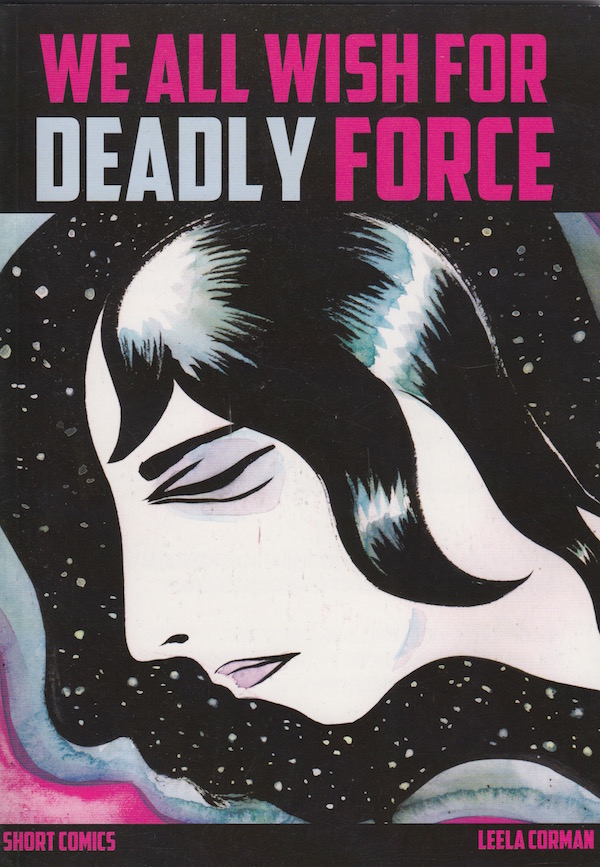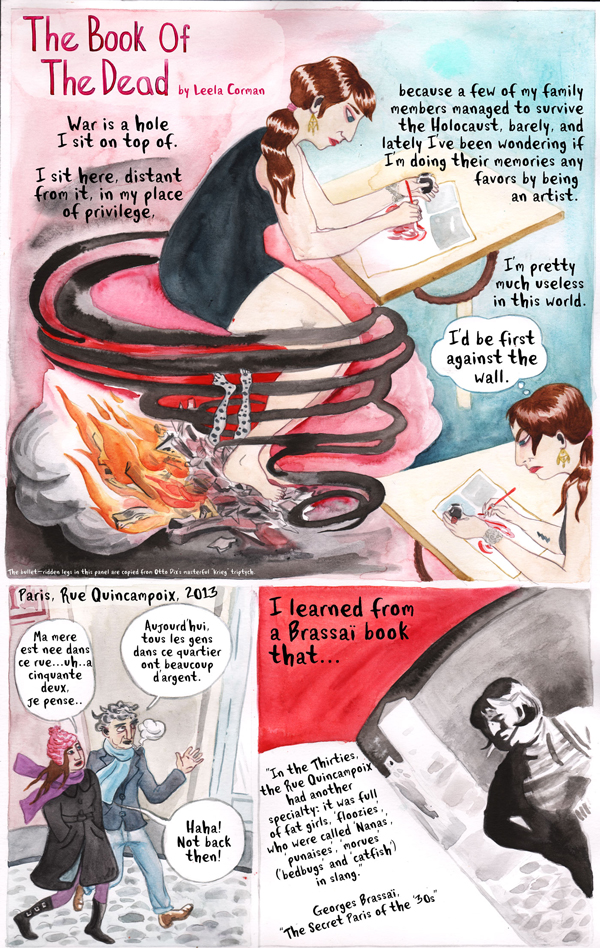Leela Corman’s work is a lot of things in We All Wish For Deadly Force. Whether using vivid, thick colors or more simple black line work, or muddy comic chimeras made up of both and more, she’s able to create an emotional landscape that perfectly enhances the philosophical intellectualism and sincere autobiography of her stories with perfection.
Corman opens with a great show of her strength. “The Wound That Never Heals” manages to walk a rough tightrope in covering PTSD following the death of a baby. The story is an act of self-reflection that features the raw intensity coupled with technical extrapolation as Corman portrays her own plunge into the depths of her own abyss, but accompanies it with clear, though not clinical, explanation. It’s a dark journey even as it’s an enlightening one, drawing you into the overwhelming emotional experience while covering the physiology of what’s happen. As a side note, if you know someone who doesn’t understand what a trigger is, Corman’s story is an effective way of helping them understand.
Much of what follows can be understood through this lens. In “It’s Always Been There,” Corman traces the historical emotional experiences common to women that are wrapped around issues of misogyny, guilt, suicide, blame, and draws a line across cultures and eras. You can’t help but also trace this to Corman’s own trauma and see the work as a way of both finding comfort and expressing anger that she is not alone. This matches the shorter, more spare pieces scattered through the book that function to capture a mood or a moment that traces how Corman’s loss is visible in the smaller moments in her life.
Later in “Yahrzeit,” she takes a dark incident in Poland in 1939 involving her grandfather that boils a huge historical conflict down to one family story, but also draws a direct line tracing loss across the decades and highlights Corman’s heightened awareness of the meaning of history.
And in “The Book Of The Dead,” Corman traces her family’s move to the United States, wrapping in Homer and homemade gefilte fish as part of the tapestry of unaddressed issues and incidents that make up generations of a family, and directly contribute to her own artistic contentment.
Corman is especially good at personalizing history, as in “This Way To Progress,” a gorgeous account of her grandparents through furniture design, which segues into wider political theory as expressed through design and the specific messages that objects send about history. It’s a fluid essay with multiple vantage points that mixes heart and intellectualism to bring comics readers a pretty vivid demonstration of how Corman’s cartooning mind works, which is again on display with Irreducibles, which examines the role Jewish identity takes in smallest moments of her and her friends’ lives, in affectations and manners, and how this is, too, is about history manifesting itself in small ways.
Not all Corman’s stories center around the trauma of loss, but all of them are concerned with women’s stories, and Corman uses her interest in belly dance as a springboard for some great ones. In “Brooklyn Bellydance Adventure,” she talks about her time teaching belly dancing and its function as a gateway to some other cultures, including some quirky Russian ladies with an amusing home remedy suggestion. Corman’s collaborations with belly dancer Luna of Cairo result in two informative pieces about Egypt and the everyday dangers for women there. One focuses on Luna’s personal experience, while the other expands to that of other women, and include examinations of their political views. These are solid pieces of comics journalism.
If you want a succinct example of Corman’s depth, of her ability to mix bigger political and historical themes with unlikely common manifestations, just look to her live-drawing the Eurovision Song Contest, and the way she takes such an innocuous, silly exercise and uses it to express the horrors of World War I, conceptualizing schlock as the price of peace. It’s a wonderful observation and the essence of what makes this collection a must-have for anyone who’s excited by the multi-faceted ideas that comics are capable of expressing.










I’ve gambled on this after seeing the sample pages at http://retrofitcomics.com/post/141200293512/we-all-wish-for-deadly-force-by-leela-corman-we (and some advance review somewhere) but it’s scheduled for October 12. Nice to know it should pay off.
“PTSD following the death of a baby”
Also related in her husband Tom Hart’s graphic memoir ROSALIE LIGHTNING from earlier this year.
Comments are closed.